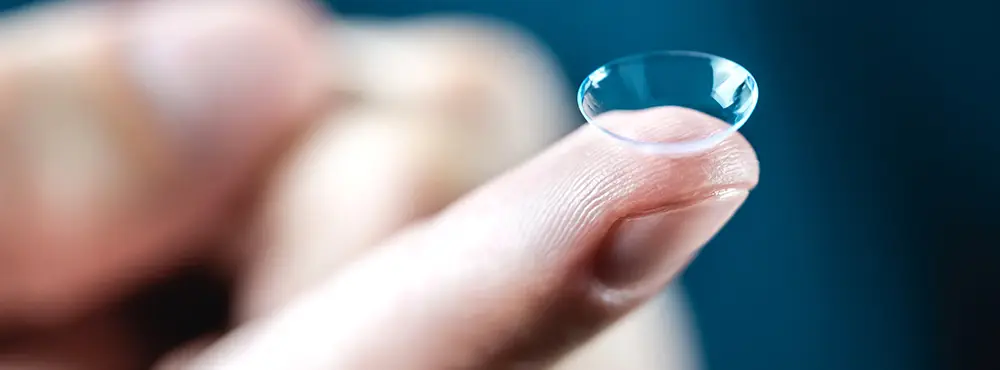Multifocal contact lenses are designed to correct vision issues associated with presbyopia; an eye condition that makes it difficult to focus on close-by objects. Presbyopia is a normal part of aging and usually develops in those aged 41-60. Fortunately, this can be corrected with the use of multifocal contact lenses (or bifocal/varifocal glasses).
How do multifocal contact lenses work?
Multifocal contact lenses work by combining multiple prescriptions in a single lens. One part of the lens works for close-up objects whilst the other part of the lens focusses on further distances.
There are different types of designs for multifocal contact lenses. The type of design determines exactly how the lens works:
1. Simultaneous vision design
With this type of design, your eye will look through both prescriptions at the same time. These lenses train your eyes to merely focus on the section of the lens that is needed depending on what you are looking at.
This design includes concentric multifocal contact lenses – these lenses contain rings on the lens to alternate between the close-up and distance prescription. This design also includes aspheric multifocal contact lenses, with these lenses the prescription gradually changes across the lens. Usually, these lenses start with distance in the centre of the lens, progressing to near vision as you move away from the centre.
2. Segmented bifocal design
Sometimes referred to as alternating vision, this type of lens contains a line to separate close and distance vision. Whether you see an object close-up or further away depends purely on which part of the lens you are using.
This design works in a similar way as the bifocal eyeglass lenses – the line of separation creates an obvious distinction between the close-up correction and distance correction. All segmented bifocal designs are rigid gas permeable lenses.
Can anyone wear multifocal contact lenses?
Multifocal lenses are generally suitable for those with healthy eyes and with some experience of wearing contact lenses.
There are some instances where multifocal contact lenses may not be suitable for an individual. For example, conditions such as severe astigmatism or cataracts can hinder the effectiveness of multifocal contact lenses. As multifocal contact lenses work using multiple prescriptions, some may not find it suitable as they may simply have difficulties adjusting.
In some cases, individuals may not be a suitable candidate for any kind of contact lenses – for example, if the individual suffers from chronic dry eye.
If your optometrist decides you are not eligible for multifocal contact lenses, they will recommend other suitable options.
How do I clean multifocal contact lenses?
Keeping your contact lenses clean is a very important part of maintaining good eye health. Poorly kept contact lenses can result in eye soreness as well as infection.
The process of cleaning your multifocal contact lenses depends on whether they are daily, monthly, or two-weekly.
Daily multifocal contact lenses
These are single-use lenses and should be thrown away after use, therefore they do not require a cleaning routine.
Monthly multifocal contact lenses
Reusable contact lenses should always be cleaned after each day of use and disposed of 30 days from opening or sooner if you experience and discomfort or irritation.
- Wash and dry your hands.
- Remove the lens from your eye and place it in the palm of your hand.
- Apply a few drops of solution to the lens and gently rub in a circular motion with the tip of your finger.
- Rinse the lens with your contact lens solution and place the clean lens into the contact lens case.
- Fill your lens case with cleaning solution.
- Repeat this process for the other lens and leave overnight for a minimum of 6 hours.
The solution that has been left in the case overnight should be emptied when you insert the contact lenses, and the case should be rinsed with solution each time, then left to air dry. For more information, refer to our ‘how to clean a contact lens case’ guide.
Two weekly multifocal contact lenses
Contact lenses that are worn for a 14-day period should follow the same daily cleaning procedure as monthly contact lenses, just remember to dispose of them 14 days from opening.
What is the difference between multifocal, monovision and bifocal contact lenses?
Monovision contact lenses
Monovision contact lenses are often prescribed for those who suffer from presbyopia. This technique to correct presbyopia consists of one lens for close-up viewing and one lens for distance vision. The dominant eye will wear the long-distance contact lens, whilst the non-dominant eye wears the close-up lens.
This form of correction is largely dependent on the brains ability to separate information. After regular use, the eyes will adapt to this way of processing information and the wearer will not notice the difference in distances.
Bifocal contact lenses
Bifocal contact lenses fall into the same category as multifocal contact lenses as they both contain multiple prescriptions. However, the difference is clear - bifocal lenses are designed with a defined line between the close-up vision prescription and the distance prescription. The transition is instantaneous compared to multifocal contact lenses which offers a more gradual transition between close and distance.
What does our optician say about multifocal contact lenses?
Our optician, Tina, says:
“Multifocal contact lenses can be a great way to correct refractive errors such as presbyopia. Providing you have healthy eyes and are comfortable with the use of contact lenses, multifocal contact lenses can offer clear vision at all distances without the need to switch between multiple pairs of glasses.”
Disclaimer: The advice in this article is for informational purposes only and does not replace medical care or an in-person check-up. Please check with an eyecare professional before purchasing any products or remedies. For information on our article review process, please refer to our Editorial Policy.

 Offers
Offers Account
Account
 Favorite
Favorite
 Basket
Basket

 OFFERS
OFFERS















